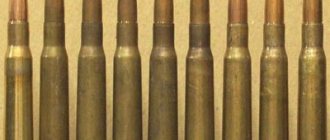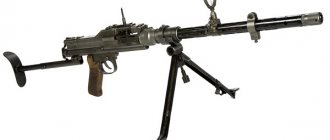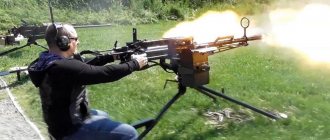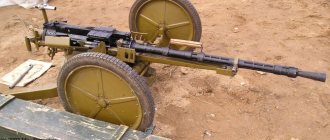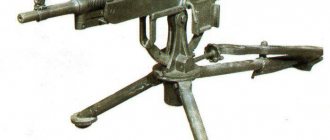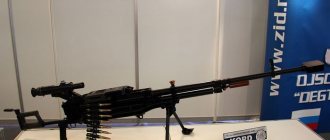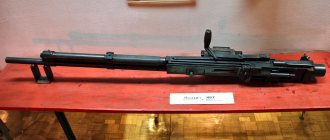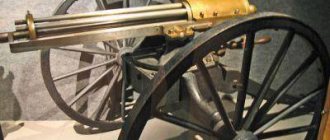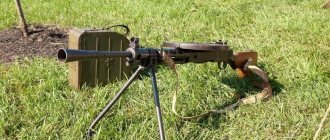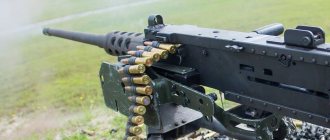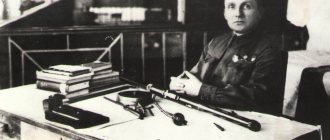The YakB 12.7 four-barreled machine gun is a large-caliber machine gun; it was developed as a small weapon for the Mi-24 helicopter. Its block of barrels rotates, like in the Minigun machine gun, created in America. Rotation allows you to achieve a high tempo when firing. The motivation for the creation of these Soviet weapons was the success of the American military. They used armed helicopters in a military conflict in Vietnam, this was in the 60s of the last century, and demonstrated to the whole world the effectiveness of using such weapons. From this article you will learn about the YakB-12.7: history of creation, features, distinctive features.
In the 60s, the Soviet Union was aimed at creating its own combat attack helicopter. This is what came out of it.
History of creation
Soviet designer M.L. worked on the project. Mile. He believed that it was not worth taking existing helicopters as a basis, and proposed creating a new combat model. According to his idea, the development was to become a flying infantry fighting vehicle, so that it would carry a lot of weapons on board: a 23 mm rapid-fire cannon, unguided missiles and ATGMs. Also, the helicopter must accommodate a personnel of 7-8 paratroopers.
The military approved the plan, but made their own adjustments when they evaluated the sketches. In their opinion, instead of a double-barreled cannon, there should be a high-speed machine gun on board. Without it, customers considered the ammunition load to be too small; 12.7 mm rounds could be taken much more than 23 mm rounds. They tried to make one more adjustment: to remove the cannon, since given the fact that there were anti-tank missiles, it seemed unnecessary. But later this conclusion was recognized as incorrect.
At that time, only one model of machine gun was provided for combat helicopters - A - 12.7. It had undeniable advantages, such as light weight and reliability, but at the same time the firepower was not as strong as we would like. This was the motivation for the development of a new model, fast-firing and designed for a large caliber.
The leading designer for the machine gun itself was P.G. Yakushev; he involved the designer from Tula, B.A. Borzov, in the development. The latter was awarded a candidate's scientific degree in 1993, when he defended his thesis on four-barreled machine guns. Yakushev already had candidate status; he defended his position in 1969. Later, the machine gun was named in honor of the developers: Yakb-12.7 - Yakushev and Borzov, caliber 12.7 mm.
The first difficulty was the choice of automation scheme. There were several options. As a basis, one could take the existing M61 Vulcan, a gun from the American creator of General Electric. It featured an external drive for the rotary barrel unit. This would allow for autonomous power supply. In addition, the design was simple and therefore durable, as well as reliable, apart from rare misfires. But despite all the advantages, there was a significant disadvantage: the weight increased almost twice due to this very external drive.
The batteries and engine really weigh quite a bit, and when it comes to aviation, every gram counts. Based on this, the craftsmen from Tula followed the example of their fellow countryman Lefty, who shod a flea and surpassed the English masters. Tula gunsmiths developed another way to set multi-barreled weapons in motion: using gases that were diverted from the barrel bore into the gas chamber. It should be noted that gas-operated weapons already existed at that time, but among them there were no models designed for a fast rate of fire. And in connection with this, some technical problems also arose that had to be solved.
Heavy machine gun "flying infantry fighting vehicle"
At the end of the 60s of the last century, the development of a specialized combat helicopter began in the USSR. In OKB M.L. Mile, where a new combat vehicle was created, the concept of a “flying infantry fighting vehicle” was chosen, capable of delivering a squad of paratroopers to the target and supporting them with fire. Naturally, the most important element of the strike complex was weapons.
In 1968, the Tula Central Design Research Bureau for Sports and Hunting Weapons (TsKIB SOO) received tactical and technical requirements (TTT) from the Air Force for the development of a high-speed aircraft machine gun intended to arm the combat helicopter being created. According to the received technical specifications, the caliber of the machine gun should be 12.7 mm, the rate of fire should be in the range of 4000-5000 rounds per minute, the weight of the sample should be about 30 kg, and the survivability of 8000-10000 rounds.
The first rotary-wing combat vehicle, designated Mi-24A, took off in September 1969. Although its appearance was significantly different from today’s, the main features of the helicopter had already been determined, and one of the main ones was powerful onboard weapons. A 12.7-mm A-12.7P machine gun with a rate of fire of 1400 rounds per minute was mounted in the bow universal installation. This machine gun was developed at TsKB-14 by designer N.M. Afanasyev in 1950 and was originally intended to arm the Tu-4 bomber. But the use of this machine gun on the Mi-24 was a forced temporary measure; work was in full swing at TsKIB SOO to create a new high-speed 12.7 mm machine gun.
In December 1968, the customer approved the technical project developed by Pyotr Gerasimovich Yakushev. The prototype, designated TKB-063, had automatic gas control and a rotating block of four barrels. An important feature of the design was the presence of a mechanical starter, consisting of a torsion spring, and a planetary mechanism, which ensured the initial spin-up of the barrel block, which made it possible to get rid of the electric motor used in foreign multi-barreled machine guns and cannons. The torsion bar spring can be cocked manually with a key before takeoff or at the end of each burst using the energy imparted to the barrel block by the last two shots in the burst. To put the machine gun into operation, a powder engine (pyrostarter) with three squibs can also be used. The machine gun is fed with cartridges from loose link tape.
In March 1970, test firing of the machine gun was carried out. Ensuring the required survivability of the barrels became a serious problem. Only when testing survivability, four machine guns were fired to their full service life. The use of a liner made of cobalt alloy KVN-2, proposed by NII-13, as well as cartridges with phlegmatized gunpowder, made it possible to ensure the necessary survivability of the barrels when shooting 400 rounds of ammunition.
Tests of TKB-063 machine gun samples carried out in 1971 at NII-61 revealed a number of shortcomings, mainly in the reliability of the automation and the survivability of parts. After the sample was refined, repeated tests were carried out in 1972, and the modified machine gun passed these tests. In September 1972, three machine gun samples were sent for ground government testing, which took place in February–August 1973. The experimental 12.7-mm TKB-063 aircraft machine guns passed state ground tests and were recommended for state flight tests.
However, despite the positive results, the chief designer of the machine gun P.G. Yakushev and the young talented designer B.A. who worked with him. Borzov continued to work intensively on the sample. The gas four-piston engine of the machine gun had a rather complex design; in fact, each barrel had its own gas engine, which, of course, reduced the overall level of reliability of the product. A large number of parts requiring separation during incomplete disassembly complicated the maintenance procedure and required complex, time-consuming assembly.
In December 1972, TsKIB SOO tested two machine guns with a new gas single-piston engine. The engine of the new design had 12 parts instead of 88. The new engine consisted of a single piston covering a single gas coupling for four barrels with two cavities into which the gas outlet holes from each barrel were removed in such a way that with each shot the powder gas flowed sequentially into one , then into another cavity, forcing the piston to perform reciprocating movements. This movement of the piston was transformed by means of a stationary copier into the rotation of a block of machine gun barrels.
In May 1973, a sample of the TKB-063 machine gun with a single-piston engine of a new design was tested by firing in conditions of rapidly changing temperatures.
In 1973, P.G. died. Yakushev. Further work on testing and testing the machine gun, resolving issues related to placing the machine gun on a helicopter and mastering its production at the Kovrov Mechanical Plant was headed by the chief engineer of TsKIB SOO V.I. Volkov, and then designer Boris Afanasyevich Borzov, who became P.G.’s successor. Yakushev and worthily continued the work of his senior comrade and teacher.
In 1973-1974 Work continued on research and refinement of the parameters of a single-piston gas engine to ensure stability of the machine gun’s rate of fire under various operating conditions.
In June 1973, the Kovrov Mechanical Plant was entrusted with the preparation of serial production of TKB-063 machine guns with a single-piston gas engine with a start date of July 1974. In the summer of 1974, control tests of the TKB-063 machine gun were carried out at NII-61. The sample was modified based on the results of state tests in 1973, had a proven single-piston engine, and passed control ground tests successfully.
In 1975-1977 Mi-24V and Mi-24D helicopters equipped with a new machine gun were flight tested, and in parallel, ground tests of suspended gondolas with a machine gun were carried out. On the helicopter, the machine gun was mounted in a remote mobile installation USPU-24, which allows firing at targets at an angle of +60° from the longitudinal axis in the horizontal plane, up to 20° up and up to 40° down. The machine gun is controlled by a navigator-operator using an aiming station. B-32 and BZT-44 cartridges are used for firing. To engage manpower, a two-bullet 1LS cartridge was developed, which increased the efficiency of firing at a given type of target by approximately one and a half times.
In March 1976, by Decree of the Council of Ministers of the USSR, an aircraft machine gun under the symbol YakB-12.7 (9A624) designed by Yakushev-Borzov was adopted as a small weapon on the Mi-24 combat helicopter.
Combat operations in Afghanistan became a severe test for the Milevsky helicopter and Tula machine gun. The YakB-12.7 was used in “close” combat, at a distance of 800...1000 m, providing a dense, accurate shower of fire, capable of turning around a blower half a meter thick. In August 1982, Lieutenant Colonel Alexandrov, having encountered a caravan of bandits near Kandahar, cut the “commander’s” bus in half with one burst from a YakB-12.7.
But intensive use of weapons in combat conditions also revealed shortcomings that did not appear during development and debugging. The machine gun actually worked at the limit in terms of temperature and component strength. With a helicopter mount carrying 1,470 rounds of ammunition, the maximum ammunition that could be fired without a cooling break was limited to 400 rounds. Overheating of the barrels during intense shooting threatened to spontaneously ignite the cartridge in the chamber.
Back in 1977, on an initiative basis, TsKIB SOO began work on modernizing the YakB-12.7 machine gun. In 1980, the Air Force was issued a technical assignment for modernization and the task was set to increase the maximum size of ammunition that can be fired without a cooling break from 400 to 750 rounds (half the ammunition capacity of the Mi-24 helicopter), while ensuring the operational reliability and safety of the machine gun (resistance to field attacks). operating conditions and heat resistance of the barrels).
After conducting theoretical research, a number of changes were made to the design of the machine gun, protected by factory, ground and flight government tests. By order of the Minister of Defense in January 1988, the machine gun was adopted by the Air Force under the name 12.7-mm aircraft modernized machine gun YakBYU-12.7 designed by Yakushev, Borzov, Yurischev. To designer B.D. Yurischev played a leading role in the search for technical solutions and their implementation during the modernization of the machine gun, the main ones of which were proposed by him or brought to implementation with his creative participation.
According to the automation scheme, the design of the main components and mechanisms, the modernized machine gun is unified with the standard YakB-12.7 and can be operated on a standard USPU-24 helicopter installation with minimal modifications to several of its parts.
To ensure that the modernized machine gun can fire 750 rounds of ammunition, the weight of the barrel block has been increased from 24 to 38 kg, and the feed has been switched off at the end of each burst, while the next cartridge remains on the feed “star” outside the zone of the chambers heated by firing.
The YakB-12.7 machine gun was installed on the Mi-24D helicopters, of which 350 were manufactured, and the Mi-24V, of which over 1000 were built. Under the designations Mi-25 and Mi-35, respectively, these helicopters were exported in significant quantities.
| MAIN PERFORMANCE CHARACTERISTICS OF AIRCRAFT MACHINE GUNS | ||
| Name | YakB-12.7 | YakBU-12.7 |
| Chuck type | 12.7x108 mm B-32, BZT-44, two-bullet 1LS | 12.7x108 mm B-32, BZT-44, two-bullet 1LS |
| Initial speed of the B-32 bullet, m/sec. | 810 | 810 |
| Rate of fire, rds/min | 4000–5000 | 4000–5000 |
| Maximum used ammunition, cartridges | 400 | 750 |
| Machine gun survivability when firing: | ||
| – 400 cartridges with 4/7 TsRG gunpowder, 50–100 shots each | 8000 | 12000 |
| – 750 cartridges with 4/7 TsRG powder, 50–150 rounds each | – | 5000 |
| Weight, kg | 45 | 60 |
| Length, mm | 1345 | 1349 |
Join our group “Courage 2004”
Share on social networks:
Design
The design is based on the Gatling scheme; it is an automatic type of weapon with a rotary block. It is driven by a gas-type side engine, under the pressure of powder gases. Each of the pistons has a connection to the engine; rollers allow movement along a curved groove on the receiver, while the receiver itself remains stationary. Such a system ensures a circular translational movement of the barrel block; this is the main link of the automatic part.
A special feature of the model is its unique starter device, which fires the first shot. Its necessity is due to the fact that the Gatling scheme requires preliminary spinning before executing the queue. After the first shot is fired, the gas engine will be connected. For this purpose, a torsion starter is provided; its shaft is located between the barrels. Before launching the helicopter, you need to compress the spring on this shaft so that it relaxes at the right moment and gives impulse to the moving parts.
When the last two rounds are fired, the spring is erected again, and energy accumulation for the next launch begins. If the cartridge misfires, the block will stop; to re-unwind it, the squib is switched on. There are three of these, this provides the ability to activate the weapon three times in case of failure. To soften the impact of the bolts, a buffer device is provided, and the firing rate is adjustable. Firing is controlled via an electric trigger.
Initially, there was a calculation for a large ammunition load, for the combat version - 1470 rounds, for the transport version - 750. The belt is very heavy; to move it, an electric pull-up of the belt is provided.
The YakB-12.7 is built into the machine gun mount of the Mi-24 helicopter with remote electric drives. This installation is located in the bow to provide wide firing angles. The location is such that both the pilot and his navigator can shoot. The pilot first turns on the sight and power to the mobile machine gun mount, then sets the sight angle taking into account the wind speed. All other settings are made automatically; for this, an analog computer is used that collects data from on-board sensors. The navigator, acting as an operator, sets the shooting mode, after which all that remains is to aim the sight at the target and open fire, this is done with a button.
The operator can shoot in any direction of the helicopter; to make this possible, a collimator sight was introduced.
It happens like this: the pilot, 5-6 minutes before the expected start of shooting, turns on the power to the machine gun installation, the operator at this time adjusts the modes and makes corrections, turns the sight head so that the visor is on the target. There is no need to control the range; this is done using the rangefinder. There are several modes: short bursts, long and continuous. If you choose the latter, there will be no more than 400 salvos in one queue, after which cooling will be required. If the machine gun operates at a temperature above ten degrees, then 25 minutes; if the temperature is from minus ten to plus ten, then 15 minutes; at lower values, five minutes is enough.
Ammunition
Another unique feature was the use of ammunition for two bullets, this was the first time in Soviet practice. Cartridges have been developed specifically for this device, in which, in addition to the main bullet, the cartridge case contains an additional bullet, it is located behind. The case was made of brass, the bullets consisted of a bimetallic shell with pressed cores made of lead and steel. The entire cartridge weighed 145 grams, initially the bullet weight was 31 grams, then it was lightened to 27 grams. Externally, the cartridge looked almost the same as a regular one intended for a heavy machine gun. But if you look closely, you can see a heel in the center of the cartridge case, this gave away the dual-bullet nature, this is the mount for the second additional bullet.
1SL and 1SLT cartridges are provided. The first is aimed at defeating light armored vehicles and manpower; it is designed for a range of 1000-1500 meters. The upper part of the bullet present in it is not painted. The second type is used when shooting at a distance of less than 1000 meters; it allows you to adjust the fire. These bullets have green tops. Such cartridges were produced at the cartridge factory in Novosibirsk. The presence of two bullets increased the dispersion of bullets, and this is a minus, but taking into account other characteristics, the effectiveness was still on average one and a half times higher.
Convenience was brought by versatility; cartridges of classical design were suitable. The ammunition included a 12.7 mm cartridge with an armor-piercing incendiary bullet; they were used to destroy ground armored vehicles, as well as manpower with individual armor protection and low-flying targets in the air.
If compared with standard cartridges for machine guns of such a large-caliber type, then in this case the ballistics were much higher. The mass of the bullet has also been increased, up to 56.6 g. From a distance of 500 meters, such a bullet penetrates an armor plate 20 mm thick, located at an angle of 20 degrees.
Aviation four-barreled heavy machine gun YakB-12.7.
Aviation four-barreled heavy machine gun YakB-12.7 (TKB-063, 9-A-624).
Developer: TsKIB. P.G. Yakushev, B.A. Borzov Country: USSR Start of development: 1968 Start of testing: 1969 Adopted into service: 1977
The rate of fire of the A-12.7 machine gun was low, so a faster-firing heavy machine gun was required to arm helicopters. According to Decree of the Council of Ministers of the USSR No. 1044-381 of December 26, 1968, the design of a new 12.7-mm rapid-fire machine gun for the Mi-24 helicopter began. Its development was carried out at TsKIB under the leadership of P.G. Yakushev and B.A. Borzov. The factory index of the machine gun is TKB-063, in advertising publications it received the designation YakB-12.7 (Yakushev - Borzov - 12.7 mm), and in the GRAU index 9-A-624. Factory tests of the TKB-063 machine gun were carried out at the end of 1969. However, the machine gun entered service only in 1977, i.e. almost nine years after the design began.
Since the rate of fire of the A-12.7 is close to the limit for a 12.7-mm machine gun, built according to the classic single-barrel design, the YakB is made with four barrels with a rotating barrel block. The YakB machine gun had a cam-type gas engine. The gas engine, cam type, consisted of a single piston covering a single gas coupling for four barrels with two cavities into which gas outlet holes from each barrel were inserted in such a way that the powder gas with each shot entered sequentially into different cavities, forcing the piston to return - forward movements. This movement of the piston was transformed by means of a stationary copier into the rotation of a block of machine gun barrels. The block of barrels is spun up with each burst of shots from a spring starter device, which stores energy at the end of the burst of shots when the block is slowed down and the last two rounds in the burst of shots are fired at that moment.
The cartridges and ballistics of the YakB machine gun were taken from the A-12.7 machine gun. In addition, a “two-bullet” cartridge was developed for the YakB. The bullet in it consists of a bimetallic shell into which steel and lead cores and an incendiary composition are pressed. The new cartridge increased the efficiency of the machine gun by approximately one and a half times.
In 1975-1977, flight tests of Mi-24V and Mi-24D helicopters equipped with a new machine gun took place, and in parallel, ground tests of suspended gondolas with a machine gun were carried out. On the helicopter, the YakB machine gun was mounted in a remote mobile installation USPU-24, which allows firing at targets at an angle of +60° from the longitudinal axis in the horizontal plane, up to 20° up and up to 40° down. The machine gun is controlled by a navigator-operator using an aiming station.
Military use showed the design flaws of the machine gun. Among which, mainly, are capriciousness from contamination and overheating of the machine gun. Problems with the movement of the cartridge belt. Also, after 250 shots, the machine gun “spitted” and jammed. As a result, the practical consumption of ammunition was up to 500 rounds per flight.
YakBYu-12.7 (designed by Yakushev, Borzov, Yurishchev) - a modification of the YakB-12.7 with a rate of fire increased from 4000-4500 to 4000-5000 rounds/min, a continuous burst length increased from 400 to 750 rounds and higher survivability machine gun (from 8,000 to 12,000 rounds). Entered service in 1978.
The GUV-8700 helicopter nacelles (one four-barreled YakB machine gun and two four-barreled GShGs) were developed especially for the Mi-24 in the late 70s.
TTX:
Modification: YakB-12.7 / YakBU-12.7 Caliber, mm: 12.7 / 12.7 Length, mm: 1345 / 1345 Width, mm: 145 / 145 Height, mm: 190 / 190 Weight, kg: 45 / 60 Number of barrels: 4 / 4 Rate of fire, rounds/min: 4000-4500 / 4000-4500 Initial bullet speed, m/s: 810 / 810 Recoil force, t: 1.4 / 1.4 Continuous length burst, duration: 400 / 750 Vitality, duration: 8000 / 12000 Projectile weight, g: 45 / 45 Cartridge weight, g: 130 / 130
YakB-12.7 machine gun on display at the Tula State Weapons Museum.
YakB-12.7 machine gun on the Mi-24V.
YakB-12.7 machine gun on the Mi-24V.
Helicopter gondola GUV-8700 (one four-barreled YakB machine gun and two four-barrel GShGs).
.
.
List of sources: Alexander Shirokorad. History of aviation weapons. Website "Corner of the Sky". 2004 page: "YakB-12.7".
Use in combat
The first baptism of fire was the Afghan War. During military operations, helicopters played a special role; they demonstrated all their capabilities and proved that they could be more effective than fighter-bomber class aircraft. A helicopter can stay above the target for a longer time; supersonic aircraft fly faster, and this cannot be corrected.
YakB made it possible to create fire of very high density and for this it received the eloquent name among the people: metal cutting. Use in combat has shown that it is effective both against targets on the ground and against objects in the air. This machine gun created a unique case in the entire history of military aviation; it was able to shoot down a supersonic jet fighter, which seemed unthinkable. This happened in the war between Iran and Iraq.
However, during the Afghan war, shortcomings were also revealed. It turned out that the YakB 12.7 machine gun fails at high temperatures in combination with dusty air. This had to be improved, as well as some shortcomings in the machine gun installation itself. Practice has also shown that it is better for the Mi-24 to fly on a mission with half the ammunition, that is, with 750 rounds.
